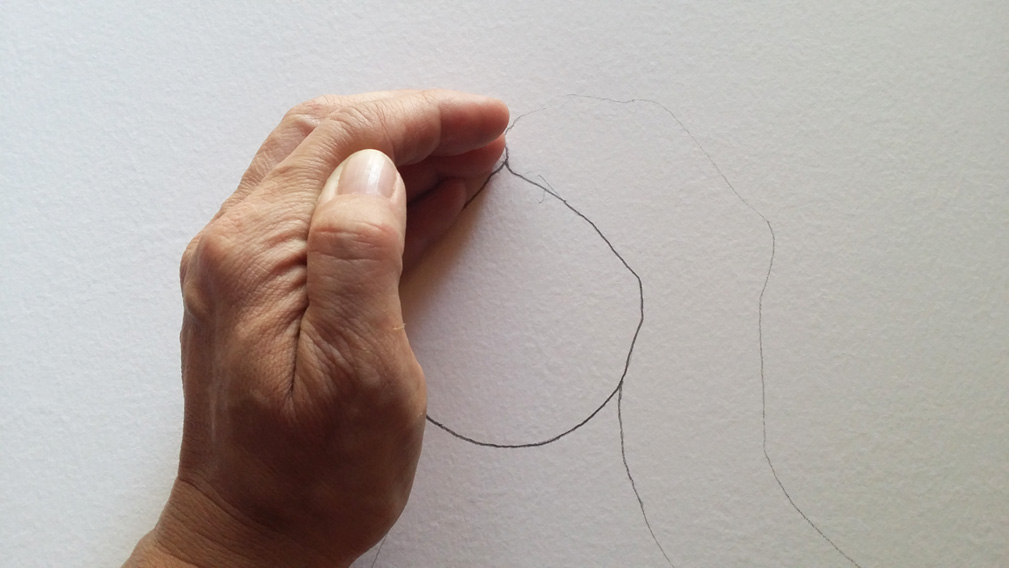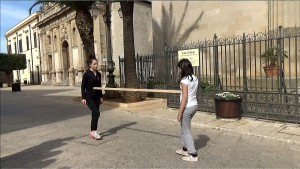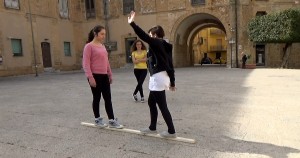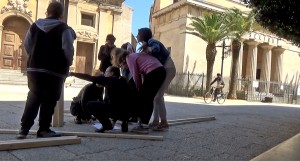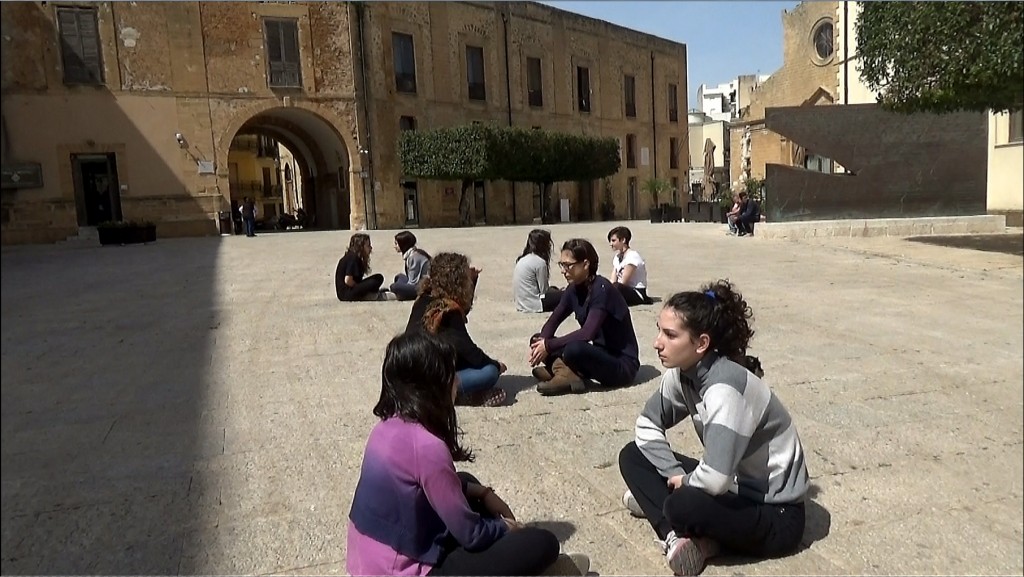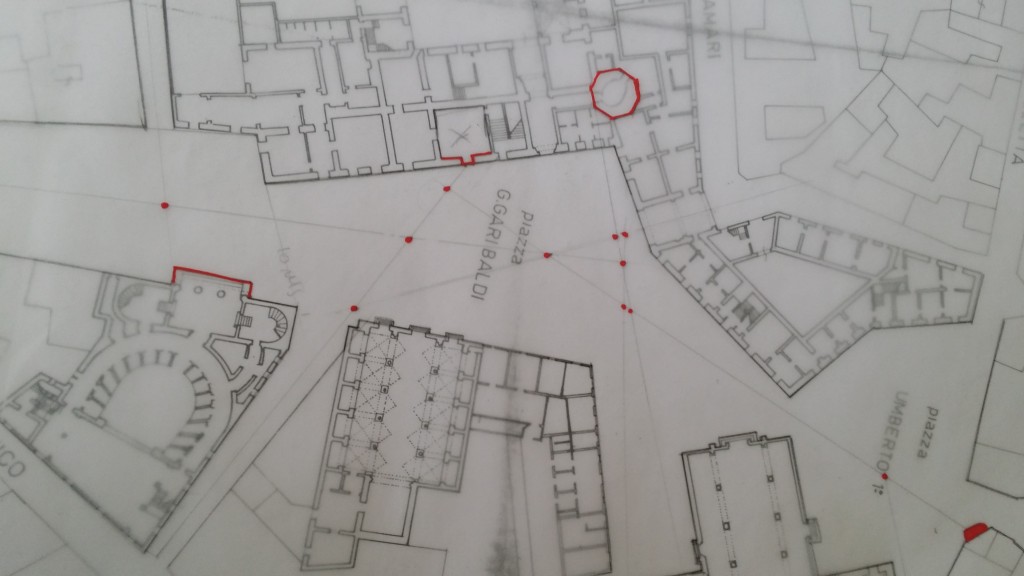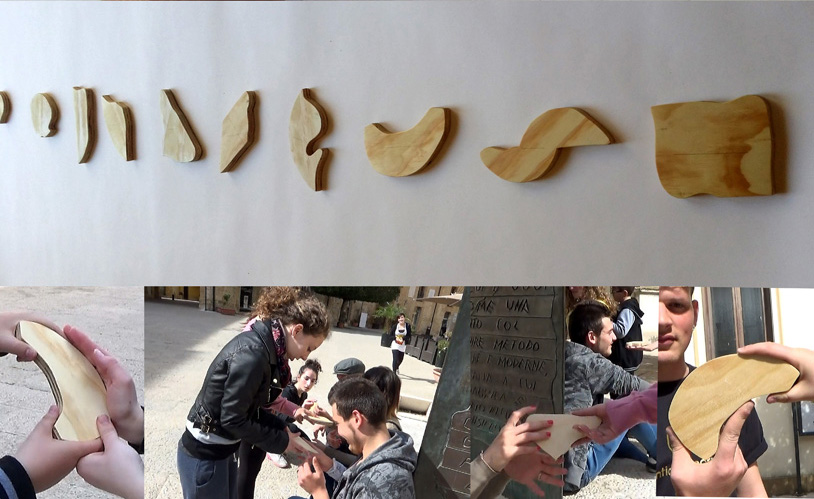Urban Interventions
lo scarto
lo scarto
Elena Cologni
Castelvetrano Selinunte (TP, Sicilia) Italy
Il progetto ‘lo scarto’¬† sviluppato da Elena Cologni, artista italo inglese selezionata per la residenza IArt in Sicilia insieme a CLAC, ha prodotto 10 disegni, 40 sculture ‘da mano’,¬† due giornate di laboratorio (22-23 aprile) e performance finale nel sistema delle piazze a Castelvetrano Selinunte il 24 aprile 2015.
The project ‘lo scarto’ developed by Elena Cologni, italian artist resident in the UK selected for a the IArt Residency in Sicily with CLAC, produced 10 drawings, 40 sculptures ‘for hands’, two workshops (22-23 April) and a final performance in the Sistema delle Piazze (central square system) in Castelvetrano Selinunte on 24th of April 2015.
teaser u spinnu 
Cologni dice: ‘ Durante la mia residenza ho cercato di capire la dinamica dialogica messa in atto da Danilo Dolci, e provato a tradurre la maieutica reciproca in termini di disegni, oggetti e performance per evidenziare il significato dello spazio e distanza tra le persone nell’atto comunicativo: lo scarto. La dimensione intima nella dinamica dello scambio uno a uno, a quella sociale piu’ ampia che pu√≤ avvenire in uno spazio pubblico, in cui inevitabilmente si incontra anche la storia.’
Cologni states: ‘ During my residency¬† I tried to understand Danilo Dolci’s dialogic dynamics, by translating his ‘reciprocal maieutics’ through drawings, sculptures and performance to highlight the meaning to be found in the space, and indeed distance between people during the communicative act: lo scarto (the left over, the scrap).¬† The intimate dimension in the one-on-one exchange dynamics, but also the more widely social engagement in public space, where inevitably history plays a role.
Workshop 1: ‘Attendendo dall’altro un raro sincronismo’ (Giuseppe Salluzzo, appunti di workshop con Danilo Dolci, 1990’s), scopo: capire la maieutica reciproca (Danilo Dolci) in ambito prelinguistico e risultato cercato: il ‘vedere’ lo spazio tra noi. | ‘waiting for a unique/scarce moment of synchronicity’ (Giuseppe Salluzzo, notes from a workshop with Danilo Dolci, 1990’s), aim: to understand reciprocal maieutics (Danilo Dolci) through a prelinguistic approach, while trying to ‘see’ the space among us.
Workshop 2: ‘struttura del silenzio (spazi fisici e temporaei)’ (Dolci, D., Dal trasmettere al comunicare, ), con lo scopo di: capire la maieutica reciproca in ambito prelinguistico, cercando di: ‘vedere’ lo spazio tra noi e l’architettura | ‘the structure of silence (physical as well as temporary spaces)’ aimed at: understanding reciprocal maieutics through a prelinguistic approach, while trying to ‘see’ the space among us and with the architecture (Dolci, D., Dal trasmettere al comunicare, )
Lo scarto quindi √® uno dei concetti di Dolci adottati, nell’evento performativo il 24 aprile nel Sistema delle Piazze, definito in collaborazione con i partecipanti ai laboratori Aurora Taormina, Francesca Bianco, Marilyn Buscemi, Valentina Cangemi, Alessandra Sparacia, Federica Passanante, Roberta Marchese, Enza Valentina Di Piazza, Irene Moceri, Gabriele Marchica, Vito Cafiso, per lo pi√Ļ ragazzi, che, lavorando in coppia, hanno voluto condividere la loro interpretazione gestuale di una serie di input come scarto, azione-reazione, ostacolo, silenzio e ascolto. Tali movimenti hanno riattivato una lettura del passato attaverso una puntualizzazione dell’architettura del sistema di piazze, testimone della storia di questo luogo in cui religione e natura, mito e scienza si sono intrecciate, e tuttora insite nella vita della sua gente (evidenziati nello schema per la performance il castello federiciano Bellumvider, chiesa di San Pietro, teatro Selinus, la fontana della Ninfa, che intersecano direzioni di scorci offerti dalle piazze)
Lo scarto thus is one of the concepts by Dolci adopted in the performance event on 24th April in the main square system, defined in collaboration with the workshops’ participants Aurora Taormina, Francesca Bianco, Marilyn Buscemi, Alessandra Sparacia, Federica Passanante, Roberta Marchese, Enza Valentina Di Piazza, Irene Moceri, Gabriele Marchica, Vito Cafiso. These mainly teen agers, worked in pair to share their movement based interpretation of such concepts as: scarto/scrap, action-reaction, obstacle, silence and listening.¬† Such movements have reactivated a reading of the past through a punctuation of the architecture, bearer of the history of this place where religion and nature, myth and science intertwined, and are still imbedded in its people’s lives (highlighted in the design for site specific performance Bellumvider Castle of Frederick II, San Pietro church, Selinus theatre, Ninfa fountain, intersecting trajectories from specific viewpoints in the squares).
‘Si ha la tendenza di passare attraverso i luoghi senza davvero viverli, la performance cerca di offrire alla gente l’opportunit√† di capire che lo spazio tra noi, cosi’ come quello intorno noi, e la sua storia ci appartengono, pur vivendoli per un breve periodo. La consapevolezza dell’ identit√† della gente in relazione ai propri luoghi √® un bene da proteggere e coltivare’ . Elena
‘We tend to go through places without inhabiting them. The performance tries to offer people the opportunity to understand that the space between us, as well as that around us, and its history belong to us, even if we inhabit them only for a short amount of time. The awareness of one’s own identity in relation to one’s own place must be cherished and nurtured ‘ . Elena
l’ascolto era alla base del nostro lavoro/listening was instrumental for our work
Ecco cosa √® successo il 24 aprile /here’s what happened on April the 24th
‘Elena, hai messo insieme artigianato, storia locale, architettura, studenti e persone comuni, creano spazi di relazione, hai ragionato e operato come avrebbe fatto Danilo Dolci attraverso al condivisione a vari livelli…dimenticavo anche con i tuoi figli, come faceva Danilo | Elena you operated by connecting craft, local history, architecture, students and passers by, producing relational spaces. You worked as Danilo Dolci would have, through sharing at various levels… almost forgot, with your kids too, just like Danilo used to.’ Giuseppe
Segue breve commento di Pino Lombardo che ha lavorato con Danilo Dolci, dopo la performance del del 24 aprile 2015 a Castelvetrano | Short comment by Pino Lombardo, who worked with Danilo Dolci. After the participatory performance 24th April 2015:
‘questo mi √® piaciuto perch√® porta il gruppo a correlarsi con l’esterno, io dall’esterno guardando trovo il momento che poi √® conclusivo importante. …..lavorare con questi giovani e nel momento in cui loro si mettono in gioco, cos√¨, seduti in piazza la gente pensa ‘ma cosa fanno?’, allora,¬† ecco,¬† arrivare l√¨ ….c’√® una crescita, una maturazione particolare, non ci si arriva cos√¨, e qui, ecco: √® il lavoro del maieuta. | I liked this particularly because it takes the group to relate to the outside. Looking at this from the outside I found this moment important…. to work with this youngsters and in the moment when they expose and present themselves, like this, sitting down in the square, and people might think ‘what do they do?’, then, to get to that point… it involves a development, a particular maturity, one does not achieve it just like that: this involves the work of a person who ‘does maieutics’ ‚Ä™. Pino Lombardo
da/from Cologni, E., ‘Reciprocal Maieutics: An Approach For The Artist As Interface In Intercultural Society’ (2015), in International Handbook of Intercultural Arts Research, London, New York, Routledge Publishing.
Il feedback avuto dai partecipanti ha confermato che attraverso la costruzione e condivisione di nuove memorie abbiamo formato una nuova piccola comunit√† con una maggiore apertura verso l’esterno. Roberta, ad esempio mi ha mandato il suo pensiero dopo la performance finale: ‘…un lavoro del tutto nuovo che mi ha formata e fatto crescere molto, sia personalmente che culturalmente. Mi ha aiutata molto il gruppo, sentire davvero gli altri ragazzi che lavoravano con me, e, guardandoci, ho notato che spesso riuscivamo a capirci senza troppe parole e a ritrovare il silenzio e la concentrazione.…Inizialmente ero un po‚Äô scettica, la mia prima parola usata quando dovevamo descriverci √® stata ‚Äúfredda‚ÄĚ. Ero fredda non a causa del vento. Conoscevo soltanto una ragazza e tutti gli altri mi sembravano molto lontani dal mio mondo. Poi, parlando e lavorando, quella persona ‚Äúfredda‚ÄĚ √® andata via per lasciare spazio ad una pi√Ļ aperta e ricettiva. Un nuovo modo di lavorare e un nuovo modo di imparare, prendere dal donare‚Ķ ‘
Ovviamente la performance finale si √® rivelata essere difficile in una citt√† non abituata all’arte contemporanea, e dove un nuomero di interferenze si sono presentate: dalle grida di gruppi di giovani, a turisti in cerca di monumenti, perfino le macchine della polizia nella zona pedonale…. e come abbiamo reagito a tutto questo?¬† Qualcuno spostando l’attenzione come Enza, che disse: ‘… √® stato molto utile ripensare al silenzio creato quando eravamo distesi… Alla fine anche le interferenze sono state integrate nel lavoro, ogni suono,voce diveniva parte dello sfondo …’ Altri hanno reagito come Gabriele, che disse di avere ‘ imparato ad adattarmi agli spazzi e ai vari inconvenienti che detta la gente.‘ Inoltre i partecipanti si spono trovati loro stessi nella posizione di aprire il contesto artistico agli altri proponendo un interazione attraverso le piccole sculture.¬† Roberta dice: “Mi √® piaciuto lavorare all‚Äôaperto, sentire gli occhi delle persone, le voci e le mani che volevano toccare i nostri lavori. Mi √® piaciuto soprattutto il momento della ‚Äúpollinazione‚ÄĚ, ho visto la gente molto incuriosita e coinvolta e questo mi ha stupida molto, non pensavo potessero avere questa reazione positiva. ” I partecipanti ai workshop erano tutti locali ed era chiaro come il lavoro fatto insieme abbia¬† rotto alcuni preconcetti da parte di tutti che avrebbero fatto ripetere comportamenti insiti nel tessuto sociale locale e tra i diversi gruppi.
Ma uno degli aspetti che ho apprezzato maggiormente √® stato l’affiorare della soggettivit√† a dare al lavoro un senso, inevitabilmente legato al contesto sociale attuale della Sicilia. Alessandra, una dei partecipanti ha condiviso con noi le sue paure e preoccupazioni per il futuro. A poche ore dalla tragedia avvenuta¬† in 19 Aprile 2015, quando circa 700 migranti persero la vita a pochi chilometri dalla costa mentre erano alla ricerca di una vita migliore. Alessandra ha anche condiviso il suo momento di comprensione dicendo che solo attraverso la conoscenza di cio’ che non si conosce (superando il gap/lo scarto) che riusciamo a vincere la paura, e questo pensiero ha preso corpo in una delle azioni nella performance finale, dove stava in equilibrio su uno degli assi di legno, mentre¬† cercava il supporto della sua compagna di lavoro Francesca.
The feedback I had from the participants confirmed that through this strategy a new established community was now sharing newly constructed memories, and a more open attitude towards others. Roberta, for instance sent me her feedback after the final performance where she stated: ‘A completely new approach which has made me grow both personally and culturally. The group helped me a lot, really feeling others working with me, and, by looking at each other, I noticed that we could often communicate without too many words, and to find silence again, and focus…..I had approached this with a bit of skepticism, my first word used when we had to describe ourselves was ‚Äúcold‚ÄĚ.¬† I was cold not from the wind. I only knew one girl in the group and all the others seemed very far from my own world. Then, through talking and working, that ‚Äúcold‚ÄĚ person left to make room for a more open and receptive one. A new way of working and a new way of learning, taking from giving.’
Of course the final performance proved quite challenging in a city not used to contemporary art, and where a number of interferences presented themselves: loud gangs of youngsters, tourists looking for monuments, even police cars in the pedestrian area…so how did the participants dealt with all these? Some by shifting the focus like Enza, who said: ‘ It has been very useful to think about silence, as we did when we were laying down in the workshop…. in the end interferences have been integrated in the work, and every sound, voice became part of the background’. Others reacted to them, like Gabriele, who ‘ learnt to adapt to open spaces and to the various glitches working with people may entail’. Moreover the participants found themselves in the position of opening up the art context to others by proposing an interaction through offering each one of the small sculptures. Roberta said: “I liked to work outdoors, feel people‚Äôs eyes, voices, and their hands which wanted to touch the works we were holding. I particularly liked the ‘pollination’ moment, I saw people very curious and engaged, and this was very surprising for me, I did not think they could have such a positive reaction”. The participants in the workshops where all local and it became clear that the work done together and the artistic activities allowed them to break preconceptions which would perpetuate existing social patterns among different groups.
But one of the aspects I cherished the most was the arising of personal narrative, which gave the work a real sense of purpose, and inevitably linked to the current social context in Sicily. Alessandra, one of the participants shared her worries and fears for the future, as our activity was just a few hours after the tragedy on 19th April 2015, when some 700 migrants died a few miles away in the Mediterranean sea, while looking for a better life. Alessandra shared with us her moment of realization, by saying that it is only through knowing the unknown (transpassing the gap/lo scarto) that we can overcome fear, and this was embedded into one of the actions of the final performance, where she was balancing on one of the provided wooden boards, while looking for support from her work partner Francesca.
***
Elena Cologni ringrazia l’organizzazione di IArt, CLAC, il Museo Civico Selinuntino e il Comune di Castelvetrano Selinunte, CRESM, Belice Epicentro della Memoria Viva Gibellina, la Rete Museale e Naturale Belicina, il Liceo Classico G.Pantaleo e l’Akkademia del Teatro Selinus e tutte le persone che hanno dedicato il loro tempo, passione, pazienza, cultura ed esperienza attivando uno scambio vitale per la riuscita del progetto. | Elena Cologni thanks the organizers of IArt, CLAC, Museo Civico Selinuntino and Comune of Castelvetrano Selinunte, CRESM, Belice Epicentro della Memoria Viva Gibellina, la Rete Museale e Naturale Belicina, Liceo Classico Giovanni Pantaleo and the ‘Akkademia del Teatro Selinus, as well as all people who gave their time, passion, dedication, culture and experience thus activating the exchange vital for the realization of the project
28 Aprile: ‘Un grazie sentito per tanta generosita’ a tutti. E’ stata un’esperienza che mi ha cambiata, arricchita di energia nuova. Al sindaco Ferrante per la promessa di custodire le mie opere adeguatamente. A Mariella Morici assessore addetto al progetto ‚Ä™#‚ÄélArt‚Ĩ per il comune, per i preziosi consigli e schiettezza. A Tania Barresi, preside del Liceo Classico Pantaleo. A Filomena entusiasta addetta del Museo Selununtino a Castelvetrano. Ringrazio tutti di ‚Ä™#‚Äélworld‚Ĩ e ‚Ä™#‚Äéclac‚Ĩ , Cristina Alga , Naida Samon√† e la nuova amica Marina Sajeva per il continuo supporto. Pietro Milici e Gabriele Gismondi professionisti eccezzionali e splendide persone. A Giacomo Bonagiuso per il prezioso aiuto in fase workshops e performance; a tutti i ragazzi coinvolti del liceo e della scuola del teatro Selinus e quelli provenienti da altri percorsi e menzionati sopra con cui ho condiviso domande, risposte e scelta a porre ‘l’ascolto’ al centro del nostro lavoro. I loro genitori. E anche a chi ha accolto la nostra offerta inaspettata e partecipato . Leonarda Paladino per l’entusiasmo nei confronti del mio approccio sulla maieutica di Danilo Dolci ed avermi introdotto Pino Lombardo, il cui incontro segna un inizio di riflessione e confronto. Fondamentale per tutto il mio periodo di residenza lo spazio del b&b SanGiovanni a Castelvetrano Selinunte , grazie a Vito Salluzzo con una soluzione ad ogni richiesta, e alla sempre sorridente mamma . All’artigiano Leonardo che ha messo a disposizione esperienza e mezzi; a Gianni Polizzi generoso e bravo fotografo. Filippo Siragusa per l’apprezzamento del mio lavoro. A Giuseppe Maiorana per aver iniziato uno scambio sull’importanza del vivere la memoria a Gibellina e a Sabrina per la riflessione sull’importanza del silenzio. Giuseppe Salluzzo per aver condiviso la sua esperienza diretta dell’approccio di Dolci e passione per l’architettura e l’arte del Belice e di Castelvetrano, sempre in perfetta sintonia. Nell’attesa di festeggiare il risultato del nostro lavoro insieme vi ringrazio davvero di cuore per avermi fatto guardare per un po’ attraverso i vostri occhi. Elena’
Short Bio. Elena Cologni studied at Accademia di Belle Arti Brera in Milan, ¬†she has a Master in Sculpture, Leeds University and a PhD (scholarship) from University of the Arts, Central Saint Martins College, Londra (2004). She won post-doctorate award (Arts and Humanities Research Council, 2004/06) at the same institution (one of the outcomes is Mnemonic Present, Un-Folding¬†series of video live installations 2005-2006), a research fellwoship at York Saint John’s University (2007/09), and she is at the moment contributing to the ¬†Commonwealth Intercultural Arts Network (University of Cambridge) (2013/14). Cologni’s interests include: resercah as art practice, documentation of ephemeral art, memory in the present, temporalities, dialogic approach in participatory practice in(ter)disciplinary. She also contributes to the Circuit program for young people led by Tate and funded by the Paul Hamlyn Foundation)
She won residencies including: at the Centre for Contemporary Arts Glasgow (to work at Re-Moved alla Biennale Glasgow international 08), at the Yorkshire Sculpture Park (Arts Council of England, UK Geomemos), at Impington College Cambridge, for the celebrations of the 75th Gropius building anniversary where she adopting an ‚Äėart as interface in society through dialogue‚Äô approach, and at the University of Cambridge, Faculty of Experimental Psychology. The Rockfluid project is the main outcome, winning two Grant of the Arts, Arts Council of England, Escalator Visual Art Retreat at Wysing Arts Centre, and Escalator live art, Colchester Arts Centre. This generated a number of site specific and participatory works such as: Spa(e)cious (Wysing Art Centre, Galleria Artra Milan, MK gallery Milton Keynes, Philosophy and performance group, performance Studies international and Kingston University Art Research Unit, Bergamo Scienza), Navigation Diagrams (MK Gallery, UK), U’ Verruzze’ and Balancing (as part of Radio Materiality, curators Vessel, Bari, Athens Biennale 2013, and Doppelgaenger Bari, Italy 2014). Rockfluid is based on a strong interdisciplinary approach to investigate creatively the impact of memory, perception and places on our identity.
